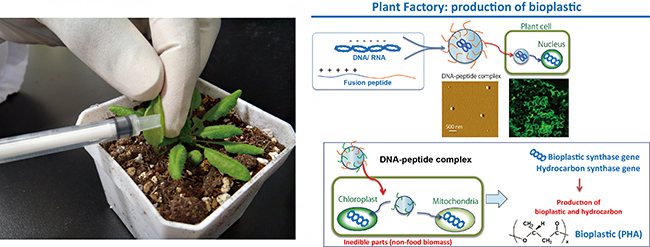Sep. 1, 2013
Development of peptide-based, easy and quick gene delivery system for plants
RIKEN No.: 07999
Inventors
Keiji Numata (RIKEN:Enzyme Research Team), Takeshi Yoshizumi (Keio University) and Yutaka Kodama (Utsunomiya University)
Background
Instead of traditional crossing technique to plants, addition of useful traits with introducing foreign genes to plant cells, would highly contribute to improvement of plants and development of agriculture. The use of genetic recombination technology in plants is indispensable in establishing new ways to replace petroleum-dependent chemical production with plant-based material production using carbon dioxide as a raw material. The agrobacterium method and particle gun method are well-known gene delivery systems. The agrobacterium method is most frequently used for introducing genes into plant cells. This method, however, is not applicable to many economically important plants. The particle gun method is more versatile than the Agrobacterium method, but it requires expensive devices, may damage genes, and has a low transfection efficiency. What is needed, therefore, is a novel and simple gene delivery method applicable to all kinds of plants.
Summary
We established a new technology which realizes an organelle transformation method by using specific peptides and silica particles, enabling biomaterials to be produced efficiently in chloroplasts and mitochondria. In this article, we describe a method to deliver genes into cells regardless of the type of their organelles. We succeeded in synthesizing a fusion peptide which contained both the arrangement of a cell-penetrating peptide and a polycation, and accordingly, prepared a complex of genes with this fusion peptide. Such prepared complexes of genes enabled us to deliver reporter genes into leaves of Nicotiana benthamiana and Arabidopsis thaliana. Attempts to further improve efficiency and achieve organelle-specificity with use of silica-nano particles, and studies of complexes comprising peptide, genes, and silica-nano particles, are now under way.
![]()
| Method |
Research phase |
Selectivity of chloroplasts and mitochondria |
Gene size |
Versatility in plants |
Convenience and versatility as a method |
| Agrobacterium |
Practically utilized |
Absent (nucleus) |
≤200 kbp |
Low (applicable only to plants which can be infected with agrobacterium) |
High (requires no special device) |
| Particle gun |
Practically utilized |
Absent (accidental) |
≤50 kbp |
High |
Low (requires special devices) |
| Our new method |
Basic research is ongoing |
≥90% (target) |
(could be) ≥200 kbp |
High (applicable to almost all plants) |
High (requires no special device) |

Plant Factory: production of bioplastic
Advantages
Our objective is to provide a simple nucleic acid delivery system which can be applied to a variety of plants and nucleic acids for plant cells. The inventors found that high gene transfer efficiency could be achieved in plant cells by usage of this fusion peptide with combined arrangements of a cell-penetrating peptide and a polycation and forming a complex after mixing the peptide with nucleic acid as gene carriers. Our nucleic acid delivery system requires no special devices, or specific microorganisms/virus, allowing multiple users to use the system. As a result, a simple nucleic acid delivery system for plant cells which can be applied to a variety of plant cells and nucleic acids can be provided.
Applications
If our study is completed as scheduled, it will enable plants, not only for research but also for practical use, to be easily used in material production technology, and create new plant species which can produce biomaterials such as bioplastics and biofuel from carbon dioxide. Results of our study may contribute to simultaneously realize the creation of new bioindustry and low carbon society, as they will enable us to also apply novel material production technology using plants and carbon dioxide to produce a wide array of materials. These include fine chemical products such as fine chemicals and cosmetics, proteins for medical use, foods, and energetic materials. Furthermore, in addition to the production of materials, our method will also be applicable to the greening of deserts or purification of contaminated soils.
References
- 1.PCT/JP2013/056062
- 2.Manoj Lakshmanan, Yutaka Kodama, Takeshi Yoshizumi, Kumar Sudesh, Keiji Numata. Biomacromolecules, Volume 14, Issue 1, pp10-16, 2013.
